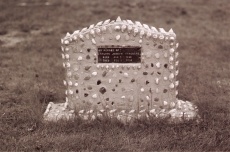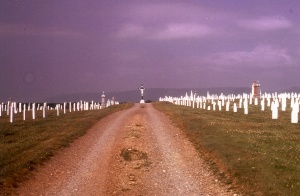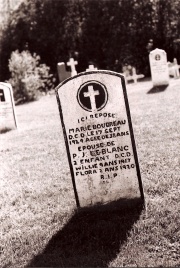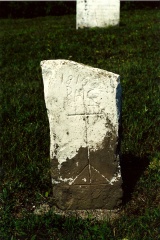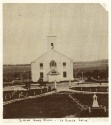Acadian Cemeteries in Nova Scotia
par Ross, Sally
A sacred place of remembrance, the Acadian cemetery has changed considerably over the centuries. Located in a rural area, beside a chapel or a parish church, the Acadian cemetery has gone from being a simple green space with a few wooden crosses to a carefully levelled terrain dominated by rows of perfectly aligned gravestones. Funerary iconography has also evolved. The cross, the flaming heart and the finger pointing to heaven have given way to secular symbols of work or pleasure, such as the fishing boat, the hunting scene, the Bingo card or the royal flush. Whether old or new, the cemetery bears witness to the customs and values of many generations of Acadians.
Article disponible en français : Cimetières acadiens en Nouvelle-Écosse
The Cemeteries of Old Acadie
Approximately 6,000 Acadians were deported from mainland Nova Scotia in 1755 and several hundred more after the fall of Louisbourg in 1758. If they were not demolished or burned by British troops, churches and chapels gradually disappeared from the landscape,. In some cases, accidental discoveries or archaeological digs have revealed the location of former parish cemeteries. Saint-Charles-des-Mines cemetery, for example, is located in Grand-Pré National Historic Site, although the exact dimensions are still not known. In the year 2000, when excavation work was being done for a housing development in Falmouth (formerly Pisiquid), several graves belonging to the old Sainte-Famille parish cemetery were unearthed by chance.
There is no proof that the Acadians who lived in Port-Royal, Grand-Pré or elsewhere, used stone monuments to mark their graves. The same is true with regard to the thousands of French men and women who inhabited the fortress town of Louisbourg on Isle Royale (known today as Cape Breton Island) in the 18th century. A 1686 map of Port-Royal provides the only known visual representation of a 17th century Acadian church and cemetery. The cemetery is surrounded by a fence which served to keep animals out and to delineate the sacred ground. Inside the fence, one can see seven small wooden crosses and a central cross mounted on a base of stones. Very few 18th century documents refer to the appearance of Acadian cemeteries, but those that do indicate that Acadians before the Deportation marked their graves with wooden crosses.
Acadian Cemeteries After the Deportation
Evidence suggests that the custom of marking graves with wooden crosses continued for a long time in the eight regions in Nova Scotia where Acadians settled between the late 1760s and the early 1790s(NOTE 1). There are no 18th century stone markers in any of the Acadian cemeteries established after the Deportation(NOTE 2). The wooden crosses placed on the graves of Acadians who returned to Nova Scotia in the late 1700s have long since disappeared. In the final analysis, it was believed that prayers, not considerations of a material nature, shortened the sojourn of the soul in purgatory. In other words, it was far more important to sing masses for the repose of the soul of the deceased than to place a monument on his or her grave. According to some oral traditions, if fifteen masses were said for the deceased, he or she would go to heaven.
Although the first church in Sainte-Anne-du-Ruisseau parish (located in southwest Nova Scotia) was built in 1808, the oldest gravestone is dated 1854. It is made of white marble and was erected in memory of Ambroise Potier, a member of the third generation of Potiers buried in the cemetery. The sculpted fleur-de-lys cross, the monogram IHS,, and the traditional request Priez pour l'âme de (Pray for the soul of) are typical of marble gravestones in Catholic cemeteries of the time. White marble was used in both Catholic and Protestant graveyards in Nova Scotia between 1845 and 1920(NOTE 3). The marble was imported and then carved by one of the gravestone companies, most of which were located in Halifax, far away from the Acadian regions of the province.
It should be noted, however, that grave markers made of marble were relatively rare in Acadian cemeteries. Only members of the clergy and a few well-off families could afford a luxury of this kind, an obvious status symbol for all Christians at the time, whether they were Acadian, English, Irish or Scottish. A photo of the old Sainte-Marie church, demolished around 1905, shows the traditional location of the Acadian cemetery beside the church. Even today, the majority of Acadian cemeteries are located next to the parish church, thus placing the living and the dead in close proximity.
Placide Belliveau's 1890 gravestone is one of the most dramatic of all the marble stones in the Acadian cemeteries of Nova Scotia. The style of his gravestone contrasts with the sobriety of most 19th century gravestones. It shows a scene of the crucifixion with six mourners at the foot of the cross. This beautiful marble stone, of unknown origin, is located near St. Mary's Bay in the old Saint Bernard cemetery which was in use from 1853 to 1943.
Funerary Traditions and Cultural Identity
The presence of marble gravestones in Acadian cemeteries indicates that Acadians appreciated the same funerary styles as the Anglophone majority in the province. In some cases, these Anglophones were Irish or Scottish Catholics who attended the same parish church as the Acadians. Contrary to Protestants in Nova Scotia, Acadians did not adopt the style of the garden cemetery. Consequently, trees and shrubs are very rare in their cemeteries. Gravestones of white marble are an indication of social stratification even in fishing villages where the majority of Acadians live, but, apart from the French-language inscription, there is nothing specifically Acadian about their design. To find elements that reflect Acadian culture, one has look at grave markers made a the local level.
Wooden grave markers have survived in a few of the Acadian cemeteries established in Nova Scotia after the Deportation. These handmade grave markers are good examples of folk art. The oldest one is located in the Saint-Pierre cemetery in West Pubnico. From a distance, it looks as if it were made of marble, but on closer examination, one can detect the grain of the wood under the old coat of white paint. It is made from a single plank. The inscription in English and the decoration (a cross in relief placed in a trefoil frame) are chiselled in the wood and painted black.
It is not surprising that the geology of a region often affects the grave markers one finds in its cemeteries. Granite is the dominant stone in most of the Acadian communities in mainland Nova Scotia. The coastline of the Chéticamp region in Cape Breton Island, on the other hand, is composed mainly of sandstone, a sedimentary rock that is relatively easy to carve. It is no doubt because of the availability of this "soft" stone that the oldest Acadian funerary monuments in Nova Scotia are located in Chéticamp. In fact, this the only Acadian region in Nova Scotia that produced gravestone carvers.
By the 1920s, concrete grave markers started appearing in most Acadian cemeteries in Nova Scotia. In some cases, they were a one-of-a-kind labour of love, like the concrete marker decorated with beach glass and shells. In other cases, they were mass-produced locally by small operations that offered durable monuments which were much cheaper than marble or granite stones. Families who had more money at their disposal could afford more elaborate concrete monuments like the one dedicated to André DeVilliers or like the one erected in memory of Évangéline Surette who died at the age of one hundred. Even today, a company in Petit-de-Grat, on Isle Madame in Cape Breton, manufactures personalized monuments, made from an aggregate, that are much less expensive than the polished granite rectangles that dominate the modern section of cemeteries throughout the province.
Acadian Cemeteries and Modern Issues
Except for a commemorative monument erected in 1955, visual evidence of the first cemetery in Chéticamp has disappeared; but the second one, which served from the early 1800s to 1868, contains about sixty sandstone markers that were straightened and placed in rows in the 1950s. In accordance with the local custom, they were also given a coat of whitewash or white paint. Some of these gravestones are rectangular in shape and have no inscription except for a simple cross and a few primitively carved letters(NOTE 4).
A small path connects this old cemetery to the huge Saint-Pierre cemetery, situated on a plateau surrounded by the Cape Breton highlands. It was opened in 1854. Except for the fact that it is located inland and on high ground quite far away from the parish church, Saint-Pierre cemetery resembles other Acadian cemeteries to the extent that the layout is strictly linear and the cental alley is dominated by a cross or a crucifix. The vast majority of the gravestones, erected before the 1940s, are made of sandstone and were carved locally. Contrary to what one sees in Acadian cemeteries elsewhere in Nova Scotia, virtually all the inscriptions are in French(NOTE 5). When we visited this magnificent site in 2003, two parishioners were repainting in white all the sandstone, wrought-iron, and cement grave markers in preparation for the celebration of the 2004 Congrès mondial acadien and the 400th anniversary of the first French settlement in North America. This whitening process, which took three summers to complete, gives an amazing luminosity to this huge cemetery, but it also makes the iconography and the inscriptions extremely difficult to read.
The two other parish cemeteries in this part of Inverness County, Cape Breton, are smaller and much less exposed. They both contain numerous beautiful, well-preserved sandstone grave markers. The village of East Margaree was founded by Acadian and Scottish families in the late 1780s. All the sandstone markers in Saint Michael's cemetery, which was opened in the early 1800s, are painted white with black inscriptions and decorative elements. The gravestone erected in memory of Marie Boudreau and her two children illustrates the old French custom of identifying the woman by her maiden name - a custom that lasted in the greater Chéticamp region until the 1970s. The custom existed, at least in the 19th century, elsewhere in Cape Breton and in the villages of Pomquet and Tracadie in eastern mainland Nova Scotia. But women are rarely identified by their maiden name in any of the twenty-one Acadian parish cemeteries in the southwestern part of the province.
Most Acadian cemeteries in Nova Scotia were subjected to an intensive "clean-up" around the 1960s, often for the purpose of facilitating the use of the lawn mower. As a rule, the ground was levelled with a bulldozer, mounds ringed with shells marking graves were removed, fences around graves were destroyed, gravestones were placed in rows, and wooden crosses and wooden markers in disrepair were thrown away. Unfortunately, priests and parishioners of the time were unaware of the cultural value of these old wooden grave markers and often regarded them as signs of poverty. Despite that, a number of these crosses and markers survived. In the course of our survey of Acadian cemeteries in 2003, we found a beautiful old pair of white crosses in a small cemetery in Quinan which does not appear to have undergone a clean-up. The wooden crosses in question are made of larch and are repainted regularly by descendants of the Doucet family. In several other Acadian cemeteries in mainland Nova Scotia, one can find wooden crosses dating from the 1930s, sometimes reinforced with a metal rod. In the large Saint-Michel cemetery in Wedgeport, attractive white, trefoil-tipped crosses with plates bearing the name and dates of the deceased have been recently placed on graves whose markers had disappeared.
A Rich Heritage to Discover
Compared to other Catholic or Protestant cemeteries in Nova Scotia, Acadian cemeteries offer a wide variety of locally-made grave markers. This is due in large part to economic conditions that forced many Acadian families to use markers that cost less than the ones sold by funerary monument companies. Even though a certain degree of social stratification existed in Acadian villages, the fractured and scattered Acadian minority in Nova Scotia was economically and politically marginalised for generations. Compared to many cemeteries in Quebec, Acadian cemeteries appear very modest. One can find the occasional column of white marble or pink granite, but there are no huge monuments adorned with magnificent statues. Despite their lack of opulence, Acadian cemeteries offer a wealth of cultural material for the genealogist, the tourist, and the historian.
Sally Ross
Independent researcher
NOTES
Note 1: For a synthesis of the history of the Acadian regions founded after the Deportation, see: Sally Ross et Alphonse Deveau, The Acadians of Nova Scotia (Halifax: Nimbus Publishing, 2001) pp. 72-143.
Note 2: In 2003, the author carried out a survey of all the Acadian cemeteries established in Nova Scotia after 1764. For the purposes of that project, an Acadian cemetery was defined as a cemetery associated with a Catholic church in a community populated entirely or for the most part by Acadians.
Note 3: Deborah Trask, Gravestone Carving and Carvers in Nova Scotia (Halifax: Nova Scotia Museum, 1978) p. 38, p. 83-92.
Note 4: For an inventory of all the inscriptions on the gravestones in this cemetery, see: Charles Aucoin, eudiste, Bulletin d'histoire et de généalogie de la Société Saint-Pierre, Vol. V, No. 4, Dec. 1988, pp. 3-5.
Note 5: According to a 1981 inventory of Saint-Pierre cemetery, there were 2, 061 grave markers with an inscription. Only about 50 of the inscriptions were in English. The inventory in question is located in Chéticamp at the Centre de généalogie Père-Charles-Aucoin.
Bibliography
Anselme Chiasson, Chéticamp - Histoire et traditions acadiennes (Moncton: Éditions des Aboiteaux, 1961).
A. B. J Johnston, Life and Religion in Louisbourg, 1713-1758 (Montreal and Kingston: McGill Queen's University Press, 1984).
Michel Lessard, "L'espace des défunts au Québec, un aménagement social ," in Frontières (Université du Québec à Montréal, Vol. 7, No. 3, 1995) pp. 13-17.
Sally Ross and Alphonse Deveau, The Acadians of Nova Scotia (Halifax: Nimbus Publishing, 2001) pp. 72-143.
Sally Ross, "Acadian Cemeteries in Nova Scotia: A Survey," in Markers (Greenfield, Massachusetts: Annual Journal of the Association for Gravestone Studies, Vol. XXII, 2005) pp. 1-33.
Sally Ross, "Aperçus de quelques vieux cimetières" in Le patrimoine religieux de la Nouvelle- Écosse : Signes et paradoxes en Acadie (Université de Saint-Anne: special issue of Port Acadie, Vol. 10-11-12, 2007) pp. 201-223.
Sally Ross and Susan Surette-Draper, "Saint-Charles-des-Mines Cemetery in Grand-Pré," http://www.acadian-home.org/frames.html.
Deborah Trask, Gravestone Carving and Carvers in Nova Scotia (Halifax: Nova Scotia Museum, 1978).
Additional DocumentsSome documents require an additional plugin to be consulted
Images
-
 Croix en bois érigées
Croix en bois érigées
à la mémoire d... -
Grand-Pré et le Basin
de Minas vus d... -
 Monument en béton de
Monument en béton de
1926, au cimeti... -
 Monument en béton de
Monument en béton de
1954 au cimetiè...
-
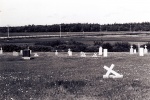 Petites croix incliné
Petites croix incliné
es en béton, fa... -
 Pierre tombale en grè
Pierre tombale en grè
s érigée à la m... -
 Pierre tombale en grè
Pierre tombale en grè
s portant l'ins... -
 Stèle en bois au cime
Stèle en bois au cime
tière Sainte-Fa...

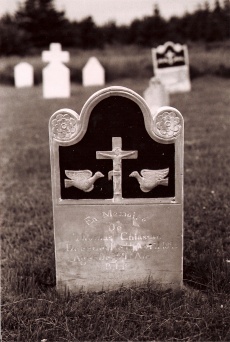
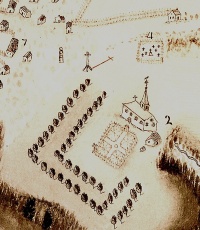
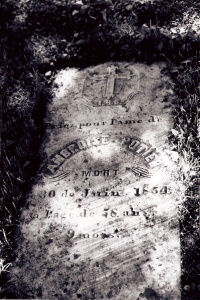
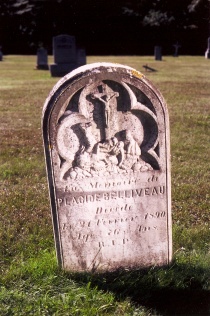
![Wooden grave marker dedicated to Lelian A L Amiro [Amirault] who died in 1897 at the age of 22 years 2 months. Photo D. Trask © S. Ross](/media/thumbs/62/170x0-Cimetiere_acadien_5.jpg)
